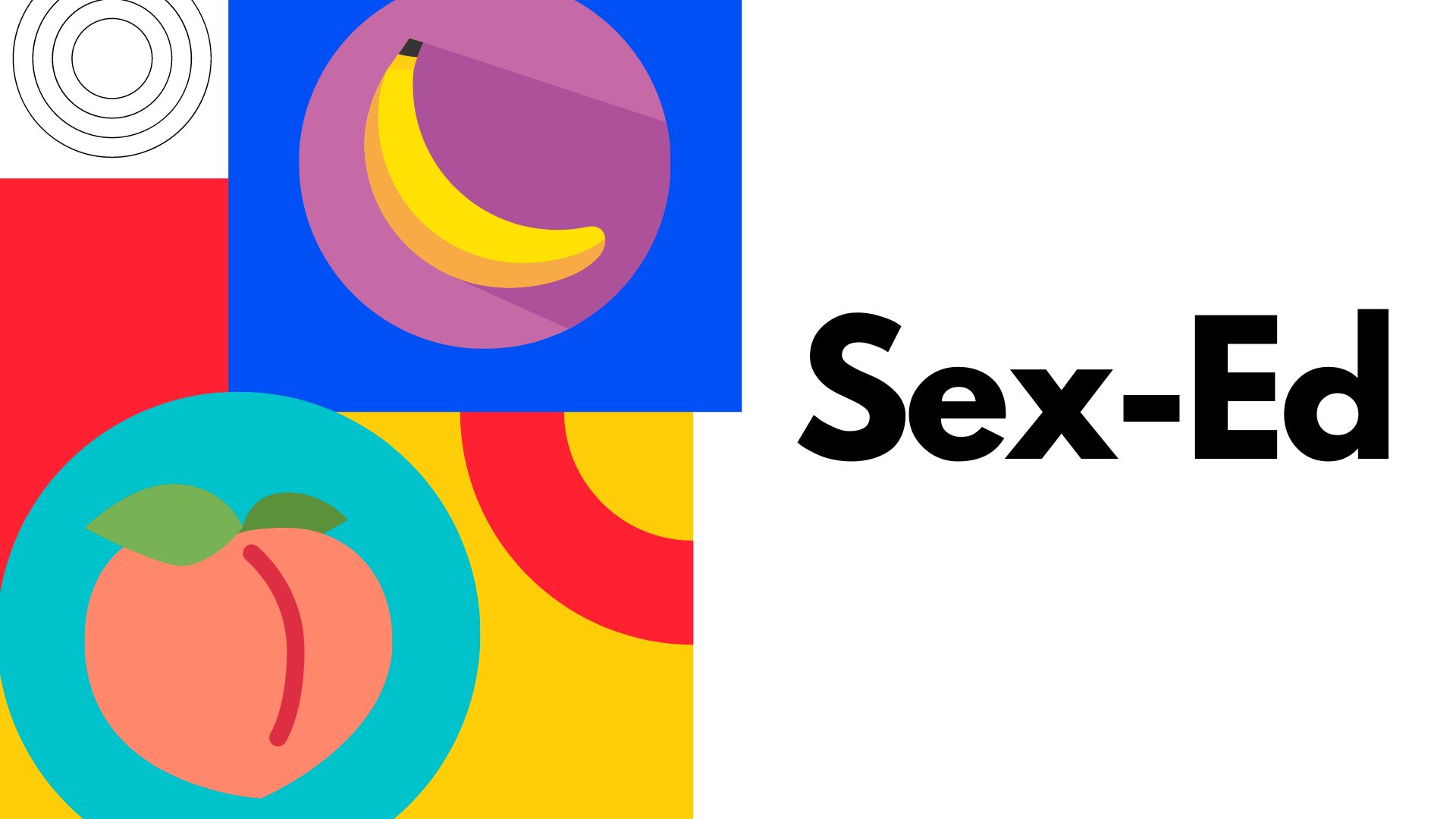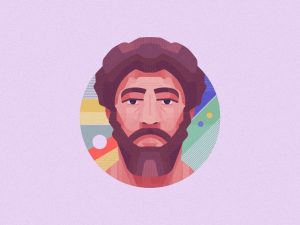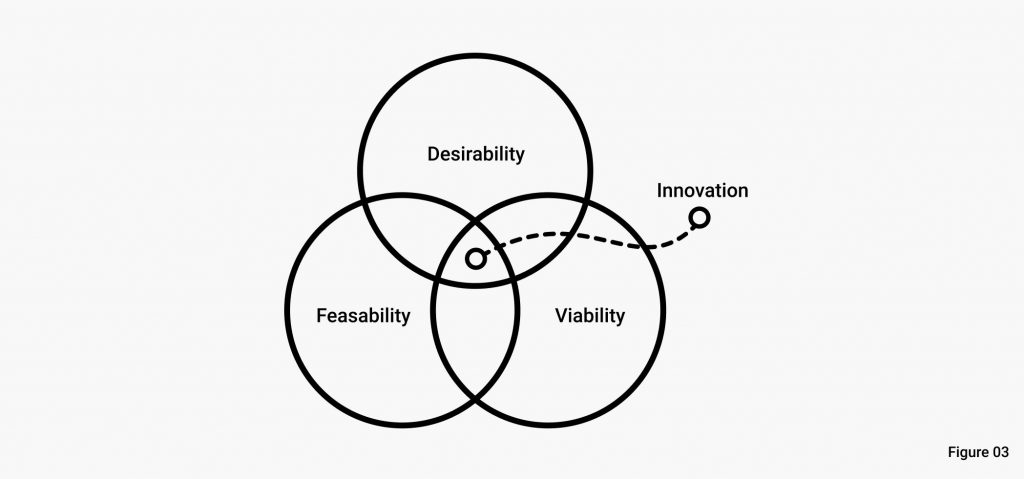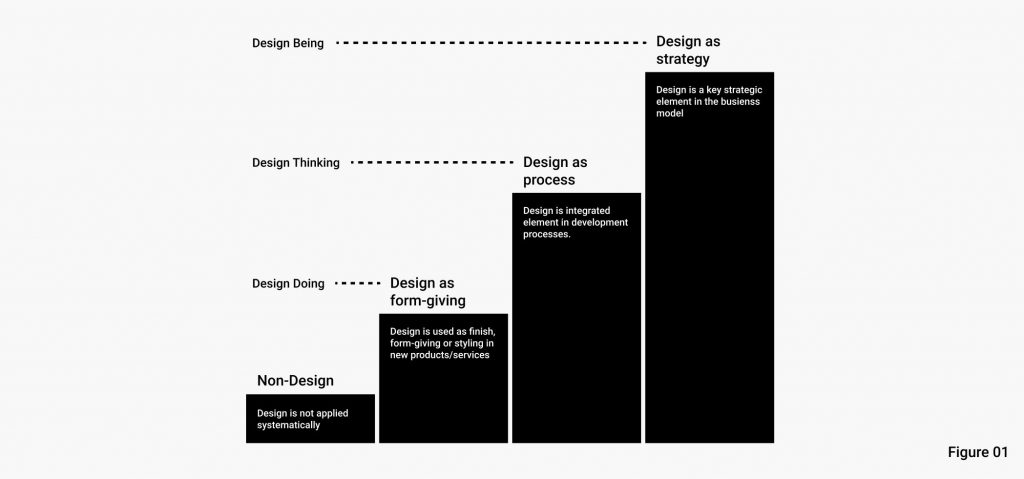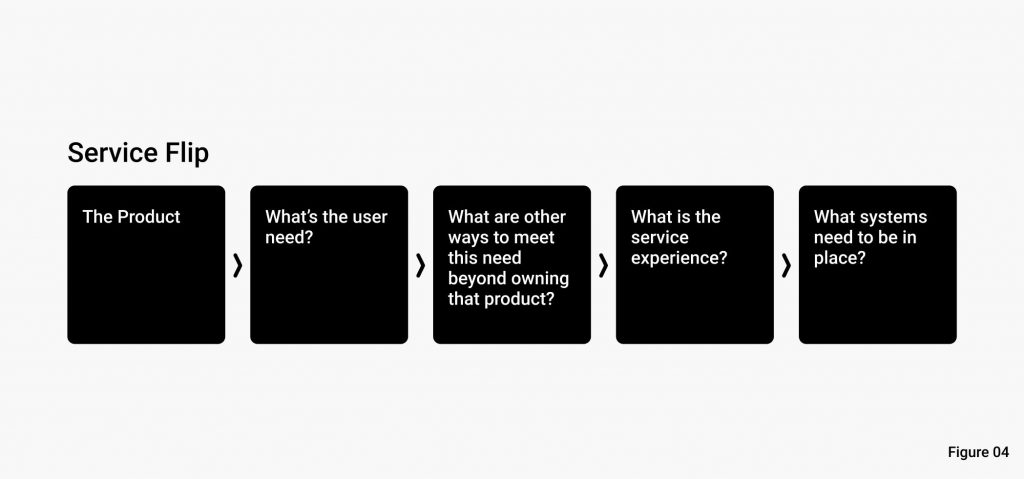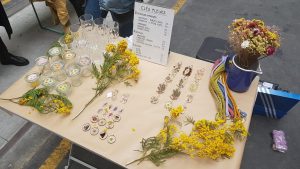How many times have you come across a situation where you felt unhappy regarding how things work in your country or the system itself? If your answer is many times, I feel you, pal; I’ve been there too.
There’s something wrong with our economic system.
If you are a college student or alumni, you might understand when I talk about the fears young people acquire throughout time—fear not to succeed in your studies and not find a good job. Fear not to make it until the end of the month with the budget you calculated at the beginning: many fears, sometimes trim options to get out of that cycle.
If you went through this sort of situation, you might not be the only one.
According to the OECD, in Spain, around 23.000 young adults under 35 years old have left the country in 2020 because they couldn’t find a job after finishing their studies. This situation hasn’t changed much since Spain’s economic crisis started in the 1980s, which has held the country as the European area with the highest unemployment rate until now.
On the other side of the world, not too far from Spain, Burkina Faso finds itself in a no-end crisis. It has the highest unemployment rate in the world. Burkina Faso is a country with a population of 13.6 million, but from 100 members of the labor force, 77 deal with unemployment , leading to poverty.

In addition to this situation, these global unemployment patterns have particularly affected young females aged 15 to 24, who are the most at risk of suffering poverty in the long term.
These rates increased during the pandemic because since time ago females are most likely to lack stability at their workplaces, receiving a lower salary, working informally, etc.
Source: Labour Force Statistics
Unemployment during the early stages of a young person can harm their future employment prospects. It affects the person’s economy in the long term, and the society’s stability too since governments have to pay a high price for these unemployed people. In other cases, such as in Burkina Faso or other similar countries, governments just drag a chain of problems that affect society’s ecosystem later because they don’t have a way to solve it.
Countries that deal with these issues are usually called “developing.”
In contrast to “developed” countries, these others present a typical pattern of a low score in the Human Development Index, which has a significant impact on people, their accessibility to basic human needs, and finally, the environment.
According to Statista and other organizations, many factors influence these cause-effect events, such as conflict or simply a low economic development level—low GDP per capita, followed by other cause-effect events.
Are the Economy and the Environment enemies?
Let’s not forget how toxic the relationship between the global economy and the environment has been for the last few years.
In the late 1960s, some scientists, industrialists, and economists started discussing a better way of applying the economy without hurting the environment. In 2002, Ms. Beder concluded that the markets would not be able to solve environmental issues. She also advised that rather than discussing the market’s lack of capacity not to harm the environment, we should instead find an ethical dimension to protect the environment.
Beder’s first statement regarding the market’s lack of capacity to solve the caused environmental harm sounds critical. As Beder, other economists, and policymakers believe that it is not the industries’ responsibility to take care of their actions in order not to cause harm to people and the environment.
Nowadays, due to the consequences of unmeasured human actions, we have something called Overshoot Day. It indicates the date when humanity has exceeded the demand for natural resources and services in a year. In 2020 we overshot Earth on August 22nd. As time passes, this date happens earlier than the year before.
According to the Global Footprint Network, to support humanity’s source demand, we require 1.6 planets. What will happen when these resources are not enough or entirely over?
Capitalism and consumerism have stepped over and have led us to a critical point. Scientists affirm that if governments, industries, and consumers don’t change their actions to a more sustainable path in less than nine years, there will be no go-back for us to recover our planet from the harm we have caused.
Yes, game over.
It is a pity that current economics’ theory defines such environmental or social issues dismissively as “externalities.”
Have we even considered the worst-case scenario if the environment stops providing resources? It could sound apocalyptic, but the truth is that if we decide not to see the fragility of our ecosystem now, no money will be able to pay the loss later.
The economy, people, and environment are firmly entrenched. Even if we want to ignore that fact, it’s not like we can escape to an island and pretend nothing is wrong because we will still be attached to this system and dragged back to it.
Money, the wrong development goal
What if I told you that the 21st century’s economic frame was based on an old idea?
In fact, it came from an idea that was drafted and designed for a society in the 1800s or even earlier. So, yes, probably if those economists could come back from death, such as Adam Smith, the Scottish pioneer in the political economy from the 1750s. He would maybe feel a bit disappointed that we could not have ideas of our own, ideas that could fit our modern world and its needs.
The current reality is that our economy has grown 300 times from the moment our financial system was instituted by economic pioneers a century ago. Even so, the system has not changed.
Perhaps there’s something wrong here, isn’t?
It is true that generation after generation, there are things about our system that have changed for good. Nonetheless, we can’t ignore those things that are still feeling like a huge pea under the mattress. One of those things is the way countries see their economic “growth.” A system based on the GDP per capita or, in more simple words, money.
As much money countries make, the best it is.
The way our financial system works might not be new to you, but the consequences that such a non-human-centered design system causes can be significantly harmful.
According to Oxfam, nowadays, 35% of the global private wealth is in the hands of 1% of the population. Adding to that, from such 1%, eight of these people are males who own the same wealth as 3.6 billion of the world’s most impoverished populations (Byanyima, 2017).
On the rapid pace that economic “growth” goes, it would not be a surprise that in some days, we get to hear in the news that there’s someone who just turned a trillionaire. Yet, if we can see around us, we will realize that there is still so much injustice globally.
Indeed, today one person in eight goes to bed hungry;
one person in three don’t have safe access to water;
one person in five doesn’t have access to electricity;
more than one person in five is underpaid in their job, earning less than $1.25 per day.
This list could go on, but it’s just proof of the unsustainable system we live in. It feels like if our financial framework has forgotten the poorest. It gives some access to the middle-class population. And finally, it enriches the rich at an overrated pace even during a health and economic crisis like the one we are currently experiencing.
Tough times give the best lessons.
Following the coronavirus outbreak, we were able to identify all those weak points the political, cultural, and financial systems currently have. The pandemic exposed the inequalities that stayed invisible under the facade of “economic growth” that many countries boast.
Many people have died during the pandemic, but not all of them have died because of the virus, but because governments had unmanaged underlying conditions, lack of access to the most fundamental human rights.
We can talk about equity when thinking about returning to the most basic human dignity principles. Equity is about ensuring that those most at risk and vulnerable can access these fundamental human needs, such as healthcare access.
Our current financial and political frameworks are reflected in how our fundamental human needs are traded and sold as commodities. Most of the time, these commodities are distributed unfairly, depending on someone’s wealth, sex, or cultural background.
Then, how could a society truly thrive?
As discussed above, our financial system and economists’ mindsets haven’t changed much since Adam Smith drew the first concept in the 1750s. It is a fact that such a system is not helping us to thrive but to destroy the only source of life we have, our Planet Earth.
The following reflection is about an old civilization that, even though it only lasted around 150 years. It left a legacy that nowadays is still remembered and somehow practiced in some parts of South America.
Unlike the present days, 600 years ago, the old Incan Empire flourished under a different political-economic system. This system was called Ayni, and it was based on reciprocity. It was a system that didn’t have any money attached to it. People exchanged labor for goods or vice versa, considering each action’s value and appreciation for one another within their community.
Incas did not export goods with outside communities, but leaders from different family tribes would exchange gifts as a sign of respect and care.
As part of their religious practices, Incas believed that the resources they obtained from the soil were a gift from mother earth, or Pachamama as they used to call it. Each season, Incas would organize religious ceremonies to return the favor to the Pachamama, preparing an envelope with sweets, grains, and beautiful handmade crafts.
Incas found a balance between people, labor, and the environment. They understood that through the practice of respect and reciprocity, they could see the actual value of each element.
Unfortunately, the Incan civilization didn’t last long after the arrival of the European colonizers. Then, the colonizers introduced monetary practices, the catholic religion, and different political construction, which forever changed their history.
History can teach us a lot, but it’s up to us to identify the takeaways from these experiences.
In modern days, some governments and economists talk about the 17 SGD’s that the UN Department of Economic and Social Affairs, along with other countries, proposed in 2015. These 17 Sustainable Development Goals were formulated and adopted by all United Nations Member States in their 2030 Agenda for Sustainable Development to promote prosperity and peace for all the people and the planet.
These initiatives’ members receive support and guidance from the UN to align with the SDGs depending on their needs.
Nevertheless, some activists such as Greta Thunberg criticize governments’ weak efforts to improve the current situation by setting mediocre goals for 2030, when it is already too late to make this right.
So, is there something that we all could start doing differently and better?
Let’s talk about the Doughnut Economic Model.
This proposal might be named as the junk food your parents used to tell you to avoid as a child. However, hopefully, in a few years, this doughnut will be known and widely used worldwide.
Kate Raworth is the designer of such an innovative economic concept. Through the doughnut, she proposes governments, industries, and citizens put people’s needs at the core while keeping a balance between human actions and the environment.
The doughnut consists of two hoops, one inside of another, forming the shape of a doughnut.
The social foundation sets the inner limit. Raworth divides these fundamental needs into twelve, all of them equally important; accessibility to water, energy, networks, housing, gender equality, social equity, political voice, peace and justice, income, work, education, food, and health.
On the other side of the doughnut, the outer hoop represents the ecological ceiling that marks the environment’s limits, which should not be overshoot.
According to Raworth, there are nine planetary boundaries; Stratospheric ozone depletion, Climate Change, Chemical pollution and the release of novel entities, Loss of biosphere integrity (biodiversity loss and extinctions), Ocean Acidification, Freshwater consumption, and the global hydrological cycle, Nitrogen and phosphorus flows to the biosphere and oceans, Land System Change, and Atmospheric aerosol loading.
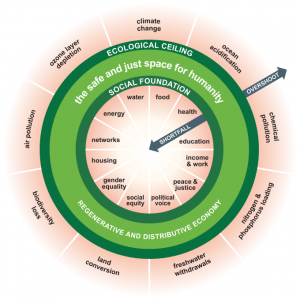
Source: Doughnut Economics Action Lab
This new model brings to focus what should genuinely matter for governments nowadays. It is not about money; no GDP per capita growth. It is about becoming distributive and regenerative by design to adapt and transform into a more balanced system that would create a just and safe space for humanity. As Raworth would say, it is about keeping everyone in the doughnut’s sweet spot.
The old economic system and its increasing monetary growth seemed to offer the necessary living standards to those countries that could afford it. In contrast, others at a disadvantage believed that money was their solution if they could finally access it one day. This cycle has undoubtedly caused implications for social growth.
A doughnut mindset is not a political position nor a new way to profit. If countries decide to implement such a model, it might be the moment to stop believing money is the only good that can make people happy.
But, how can a food-shaped model be good for us?
As shown in the graphic below, human actions have exceeded both limits of the doughnut. Within the inner hoop, there’s an apparent shortfall of resources that couldn’t reach people and offer them access to the most basic needs, such as peace & justice, e.g., in countries of conflict in the Middle East.
On the other side of the doughnut, we got nothing new to the bigger hoop’s outer part but the problematic biodiversity loss, carbon emissions at its highest, followed by the already known climate change.

Source: World Economic Forum
Nevertheless, the issues mentioned above could be seen differently if our economic system switched on its core. Living under an economic model that focuses on maintaining a balance between the social foundation and the planetary boundaries rather than money could help our society step forward towards a more peaceful phase of human history.
Throughout this blog, it was discussed and analyzed many downsides of the current economic system. It could even be said that this analysis has been a complaint thrown in the air. Undoubtedly, it provides a sense of relief.
However, there’s no happy end if we don’t see that this solution is working.
Holland is one of the first countries to dare to tackle capitalism through this new economic model. One of the most recent activities was inspired by the model during a tough time, such as the current pandemic.
After Amsterdam entered into lockdown, the authorities realized that there was an issue regarding connectivity that could negatively affect citizens’ jobs and studies. Many citizens did not have a laptop or computer at home.
In contrast to other countries, Amsterdam authorities opted for a solution that could do good to people and the environment.
Rapidly, the government organized a collection of e-waste from households and took what they already had in hand by then. They hired a company that could disassemble and assemble worthy spare parts to make fully functional computers as fast as they could.
They distributed the devices, and then the connectivity problem was solved along with other positive side effects.
Many other countries have decided to learn about this model during the pandemic and implement it soon at home.
Governments, industries, and US!
The implementation of the doughnut model in the real-life world could mean many positive changes. However, it doesn’t mean that only governments will do all that is needed to do. If this idea has sound convincing to you, how could we become part of this revolution without directly participating in politics? The answer to this question could be simple.
We must start looking at what we shop, eat, wear, travel, vote in politics, earn a living, volunteer, and observe all those small actions of our daily life.
Understandably, the action part can be challenging. But I encourage you to get to know more about what you do; it can be as simple as asking about the origin of the avocado you buy at the supermarket. Knowing your food origins can help you calculate how far your food has traveled to get to your hands. Therefore, do the calculation of how much carbon emission it has produced.
If you are not an economist or politician, I encourage you to keep learning about the Doughnut and new other economic models. As mentioned before, the economy is an entrenched science in our daily lives. It is something we can’t avoid, but we can change. Our current financial system was designed by people and can be changed by people too; it only needs to be updated.
Written by Idoia Paucar Herrera
References
Beder, S. (2002). Economy and Environment: Competitors or Partners? Pacific Ecologist 3(Spring), pp. 50-56. https://documents.uow.edu.au/~sharonb/pacific2.html
Byanyima, W. (2017, Jan 16). 8 men have the same wealth as 3.6 billion of the world’s poorest people. We must rebalance this unjust economy. World Economic Forum. Retrieved March 21, 2021, from https://www.weforum.org/agenda/2017/01/eight-men-have-the-same-wealth-as-3-6-billion-of-the-worlds-poorest-people-we-must-rebalance-this-unjust-economy
Chainey, R. (2017, April 21). 15-hour weeks, basic income, and doughnuts. Are these the big ideas that could end inequality? World Economic Forum. Retrieved April 1, 2021, from https://www.weforum.org/agenda/2017/04/15-hour-weeks-basic-income-and-other-big-ideas-for-a-new-economy/
Charlton, E. (2019, May 19). Here’s why the world’s recovery from COVID-19 could be doughnut-shaped. World Economic Forum. Retrieved April 01, 2021, from https://www.weforum.org/agenda/2020/05/doughnut-model-amsterdam-coronavirus-recovery/
Doughnut Economics Action Lab. (2020, September). About Doughnut Economics: Meet the Doughnut and the concepts at the heart of Doughnut Economics. Doughnut Economics Action Lab. Retrieved March 20, 2021, from https://doughnuteconomics.org/about-doughnut-economics
Earth Overshoot Day. (2021). About Earth Overshoot Day. Earth Overshoot Day. Retrieved April 02, 2021, from https://www.overshootday.org/about-earth-overshoot-day/
Nugent, C. (2022, January 22). Amsterdam Is Embracing a Radical New Economic Theory to Help Save the Environment. Could It Also Replace Capitalism? TIME. https://time.com/5930093/amsterdam-doughnut-economics/
OECD. (2020, May). Unemployment Rates, OECD. OECD. Retrieved April 1, 2021, from https://www.oecd.org/sdd/labour-stats/unemployment-rates-oecd-update-may-2020.htm
O’Neill, A. (2021, March 31). The 20 countries with the highest unemployment rate in 2017. Statista. Retrieved April 02, 2021, from https://www.statista.com/statistics/264656/countries-with-the-highest-unemployment-rate/
Simpson, A. (2017, August 23). Episode 2: Kate Raworth on ‘Doughnut Economics. The Next System Project. Retrieved March 28, 2021, from https://thenextsystem.org/learn/stories/episode-2-kate-raworth-doughnut-economics
WHO. (2019, June 18). 1 in 3 people globally do not have access to safe drinking water – UNICEF, WHO. World Health Organization. Retrieved April 28, 2021, from https://www.who.int/news/item/18-06-2019-1-in-3-people-globally-do-not-have-access-to-safe-drinking-water-unicef-who
